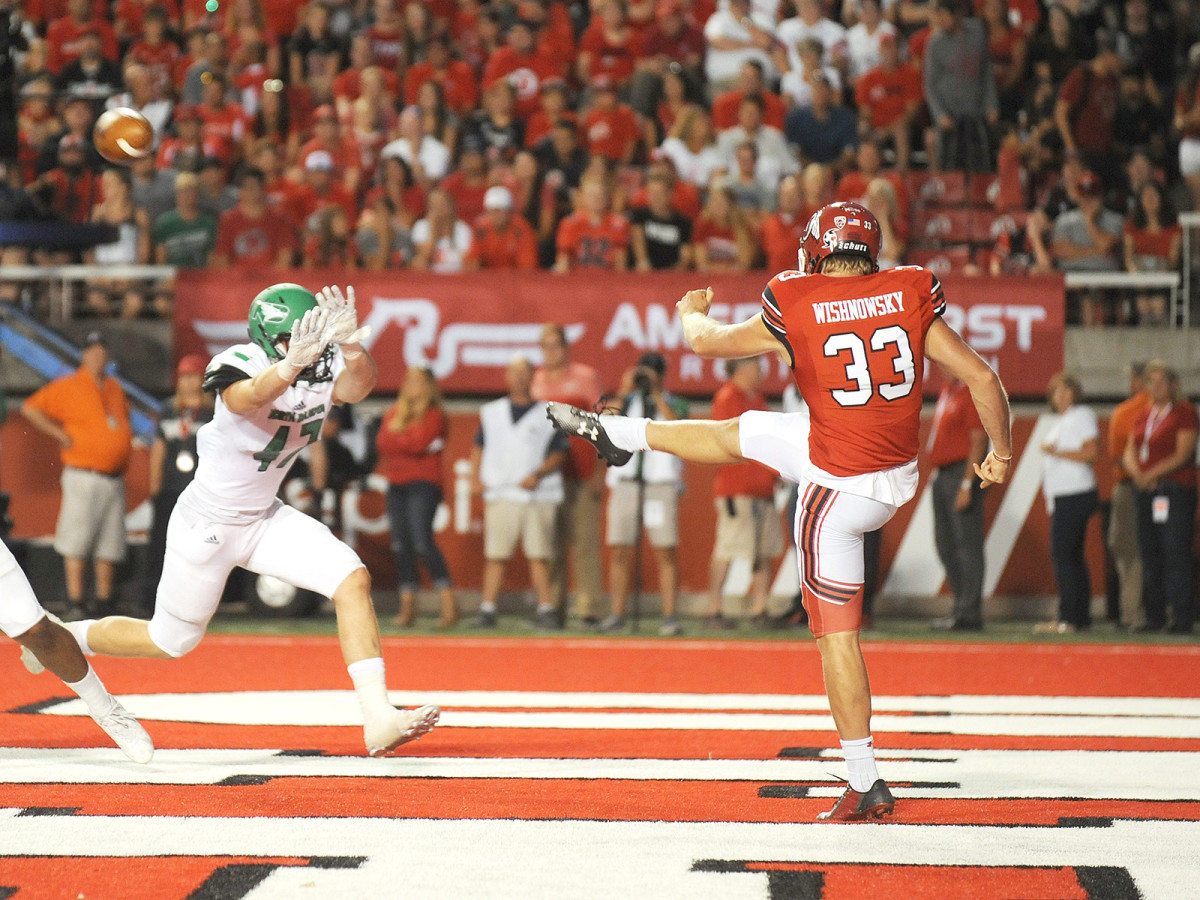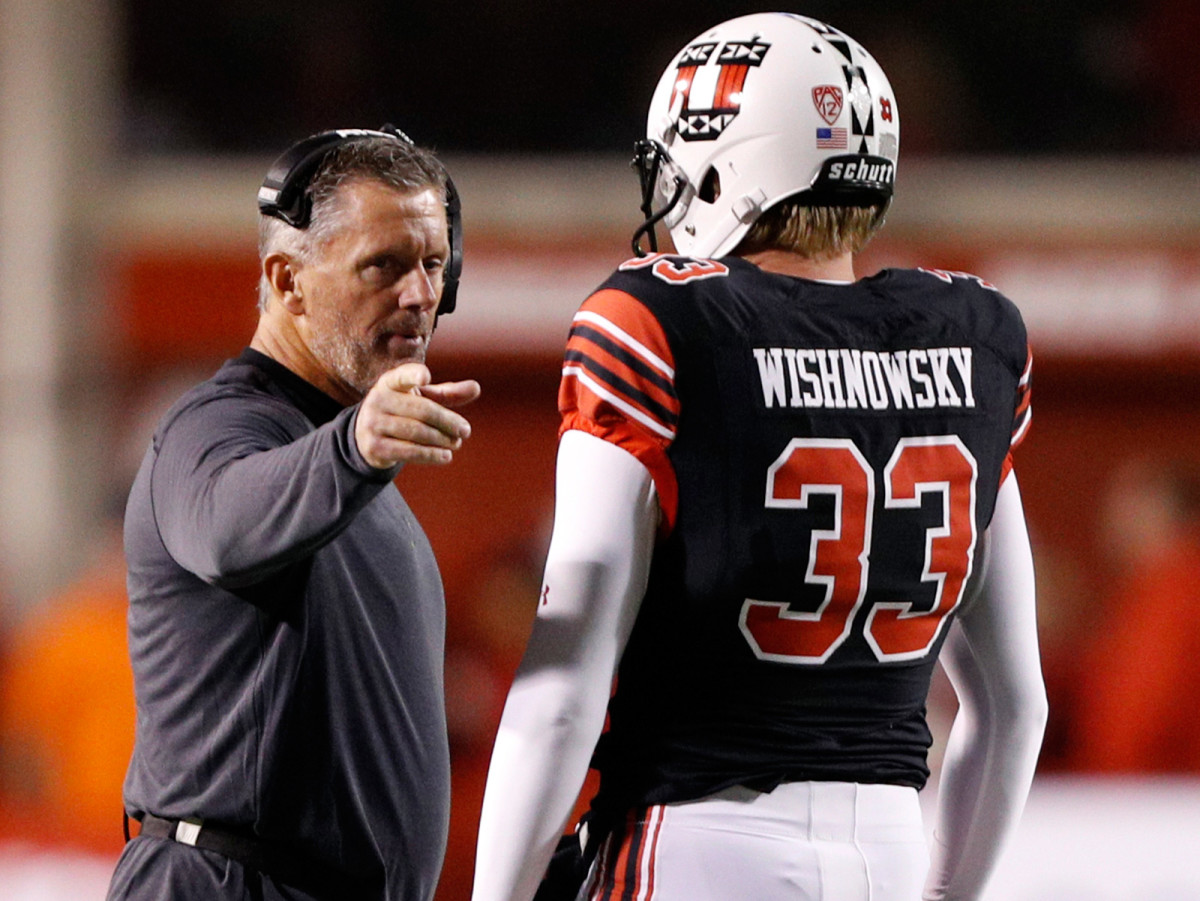Mitch Wishnowsky and Utah Are Setting the Pace in a New Phase of the Australian Punter Pipeline

This story appears in the Aug. 13, 2018, issue of Sports Illustrated. For more great storytelling and in-depth analysis, subscribe to the magazine—and get up to 94% off the cover price. Click here for more.
He was a legend before he arrived in Salt Lake City, the 23-year-old freshman from the other side of the Earth. The chatter started in late 2015: Have you heard about the new Australian punter the Utes are bringing in? None of the Utah players had seen much video. The Internet yielded a head shot, at least, to those who were curious: a shock of long, straight blond hair with a face buried behind it. And a name: Mitch Wishnowsky.
At the time Utah seemed likely to take a step back on special teams. Tom Hackett, who had introduced the Pac-12 to the Aussie on-the-move style of punting, was training for the NFL draft after winning two consecutive Ray Guy Awards. (Only two others have earned the honor multiple times since its inception, in 2000.) Hackett's success seemed impossible to replicate—until the Myth of Mitch began to build. As senior wide receiver Jameson Field recalls hearing, “He’s just this stout human being, just this physical specimen that’s playing punter. He’s this Thor-looking punter who’s about to come in and run faster than all the receivers and be stronger than all the linebackers.”
When Wishnowsky arrived on campus, his appearance lived up to the legend: 6'2", 220 pounds and, yes, looks and locks that called to mind Chris Hemsworth's as the Marvel superhero. But teammates soon realized the reserved high school dropout from Perth was no star in conditioning drills. Like Hackett, Wishnowsky had spent years focusing on his leg and was unprepared for the physical demands of training for major-conference football. Thor got shin splints.
Quickly, though, he proved himself. In 2016, as a sophomore, Wishnowsky not only finished first in the nation in kicks downed inside the 10-yard line (17) and second in punting average (47.7 yards), but he also followed Hackett as the Ray Guy winner. He averaged 43.9 yards with 10 downed inside the 10 last season, as Utah finished No. 5 in Football Outsider's punt-efficiency metric. Also among the top 10 were two other programs with punters hailing from Down Under: Michael Dickson of Texas, who claimed the 2017 Ray Guy Award; and Josh Growden of LSU. And this season, across the FBS, 30 teams feature Australian punters. In a sport in which teams will do anything to get an edge—offer a scholarship to an eighth-grader, lay down turf in every color of the rainbow, dole out impermissible benefits like lollipops at the pediatrician’s—the key to success on special teams can begin in another hemisphere. For coaches willing to recruit over Skype, Australia just might have their man.

GLAY-ZEE-AH. That’s how Wishnowsky says it, glazier, a word that seems almost too elegant for American English. Glaziers install glass, and in 2008, when the 16-year-old got an offer to quit school and work for a glazing company outside Perth, he grabbed it. The job offered a stable future, the benefits were substantial and the salary enabled him to buy a house in his hometown with his best mate.
Problem was, Wishnowsky hated glazing.
He had always been good at Australian Rules football—a rough, fast-paced, wide-open sport also known as footy—but he had to give it up at 18 after repeatedly injuring his left shoulder. Still, he continued to play flag footy with friends, one of whom had a connection to a fledgling operation in Melbourne. Called Prokick Australia, it's run by Nathan Chapman and his business partner, John Smith. Its mission: to help strong-legged Aussie Rules players make it in American football, following in the footsteps of Pro Bowlers Darren Bennett and Mat McBriar as well as the handful of other punters who have had NFL careers.
A footy full-back in the 1990s, Chapman focused on punting after a pileup of injuries from the sport; he hurt his hamstrings, groin, right MCL, ankles, right hand and right shoulder. In 2004 he came to the U.S. on a contract with the Packers and was later on the offseason rosters of the Bears and the Bengals, but he never made it out of training camp. When he ran out of money he returned home, convinced he'd gone about the process the wrong way. He hadn't known enough, and he had started at the wrong level. He should have gone to college first.
Chapman launched Prokick in 2008, and even though he couldn’t afford training facilities—enrollees paid for their own gym memberships and sneaked onto practice fields—he didn’t accept just anyone. Players needed to be able to kick an American football at least 45 yards, with a 4.5-second hang time, to even be considered. He was looking for the continent’s strongest legs—but had no real résumé to attract them. “We’re only successful now,” Chapman says, “because we were too stupid to stop.”
In the early years just a few qualified candidates expressed interest. Now, dozens meet the prerequisites and are willing to pay the $15,000 tuition—a hefty check that they hope yields a college scholarship. In footy, teams advance over a field around 180 yards long either by a handball, in which the player holds the ball with one hand and punches it with the other fist, or by a kick, which can travel as far as 80 yards. Sides of 18 players swarm, collide, use one another as human springboards—anything to lay a hand on the egg-shaped leather ball that's slightly larger than its American counterpart. At either end of the oval field are four goalposts; kicking the ball between the narrower set of posts nets six points and through the wider one nets one. The most common kick is a drop punt, in which a player holds the ball, laces out and vertical, in his dominant hand before dropping it, mid-run, to his dominant foot. It travels end-over-end, but the mechanics are similar enough to a spiraling American punt ... yet different enough that’s there’s plenty to learn, and much for Chapman to teach.
Most of the early Prokick students, like Hackett, lived near Melbourne and didn’t have to relocate. By the time Wishnowsky arrived in 2012, more players had picked up and moved to enroll, and Chapman had solidified his curriculum. He works on eliminating the hip swing that marks footy kicks, relaxing the shoulders, adjusting the eye angle. There’s a unit on teaching players to tilt the ball on its axis and another on the approach; Aussie Rules kickers are accustomed to a long running start, which Chapman shortens to a few steps—still longer than a typical punter’s approach—from a slight diagonal. Throwing every tweak at once into a motion that lasts barely two seconds would be overwhelming. “It feels weird, because you’ll [get one adjustment] right, but everything else is wrong, and the ball is horrible,” Wishnowsky adds. “You want to go back to your normal style, because it gets you a decent ball. Chappie is just like, ’No, please, stop, do what I say.’ It’s just doing one thing at a time.”
Chapman also built up his pipeline to FBS. By 2013, Hackett was punting at Utah, Jamie Keehn at LSU and Cameron Johnston at Ohio State. Will Gleeson started for Ole Miss the following year and Nick Porebski for Oregon State the year after that. Watching games in the wee hours of Sunday mornings, Chapman saw his players succeeding almost immediately, so he buckled down even more during Wishnowsky's time in Melbourne. “It used to just be like, Turn up whenever, chill out, drink your coffee,” Wishnowsky says. But suddenly, Chapman was telling players to arrive on time, to warm up before their workout. “Warm up?” Wishnowsky recalls asking. “We don’t warm up.”
Chapman’s players don’t field scholarship offers—and that’s by design. Instead, he serves as a matchmaker between program and player, saying that coaches “are just ordering a pizza. You tell us what you want, and we’ll deliver it. Do you want a big spiral guy? Do you do rollout? Do you want a guy who’s like this player? Do you want a guy who’s like that player? ‘Oh, I’ve played against Tom Hackett or Mitch Wishnowsky for the last three years. I like that.’ O.K., but when I tell you I’ve got him, you need to have that scholarship ready.”
The Utes were so pleased with Hackett’s early returns that they agreed to take Wishnowsky even though he needed time to gain eligibility. A year of Prokick, a year playing at Santa Barbara City College, a year as a redshirt, and he would be ready right as Hackett left.
And he was. Wishnowsky, like most Australians, began his punting career with just a basic knowledge of the rule book—essentially, that he had to jog onto the field only when the scoreboard read “fourth down” and his team was out of field goal range. He grasped much more during his juco season, in 2014, and in ’15 he redshirted, remaining in Santa Barbara to finish his associate’s degree and conserve eligibility. That year he helped his successor at City College, countryman Joel Whitford, get his bearings. In a midseason game the Vaqueros ended the second quarter on third down, backed up in their own territory. Whitford, who’s now at Washington, complained to Wishnowsky about the punt he’d have to make at the start of the next quarter if the team didn't improve its field position. Wishnowsky laughed. “It’s halftime, mate,” he told Whitford. “You don’t have to punt.”

Almost all of the Prokick grads have only the vaguest idea of what they’re getting into. In the quest for a U.S. college degree and maybe an NFL career, they have left their homes and their families, sometimes moving 2,000 miles to Melbourne, where they learn to embrace a strange new sport. Hackett remembers feeling grateful that Chapman had taught him to put on pads—which was about the extent of his knowledge of the minutiae that first season in Utah, when he spent much of every game staring mesmerized at the crowds of 45,000 at Rice-Eccles Stadium.
When Wishnowsky reported to Prokick in 2013, he boarded the five-hour flight to Melbourne with no clue where he’d live, crashing at first in a spare room at Gleeson’s parents’ house. Most of his knowledge of American football came from watching the 2005 remake of The Longest Yard—which is to say, he imagined playing in a prison yard on a team of convicts. After Gleeson left for Ohio State, Wishnowsky found his own apartment; to pay for it he bartended until 2 a.m., and got by on four hours sleep, perpetually tired but finally with a purpose. “I was still happier than [when I was] glazing,” Wishnowsky says, “because I knew I was working toward something that I actually wanted to do.”
In the weight room on one of his first days of practice with the Utes, the team took roll call. Here, here, here, hee-yah. Wishnowsky’s accent was so thick that strength and conditioning coach Doug Elisaia couldn’t understand him. Wishnowsky? Hee-yah. Wishnowsky? Eventually, someone spoke up, tight end Jake Jackson recalls, shouting to the coach that indeed, Wishnowsky was both hee-yah and present.
Utah’s Aussies are most noticeable when they open their mouths. When he first arrived in Salt Lake City, Wishnowsky said he was borderline invisible until he spoke up to order food or to buy a textbook. The same question usually followed: “Are you Tom Hackett?”
Despite the similar dialect, the two punters couldn’t look more different. On a Tuesday in July, Wishnowsky is in for offseason training decked out in red Utah gear. He has the build of a linebacker, and his once-flowing mane is shorter and more unruly. Hackett is a sports-talk radio host in Salt Lake City—the Jets cut him during training camp in 2016—and has lost most of the muscle he built up as a player from his 5'11" frame. He dresses as if he fronts an indie band: striped T-shirt, round Ray-Bans, faded jeans rolled up at the cuffs, kelly-green kicks.
Their punts are no more alike. Hackett was precise, making up in accuracy what he lacked in power. Of the 242 punts he launched over his Utah career, only 26 went for touchbacks. Wishnowsky, on the other hand, spends more time refining his hang time and precision, guarding against a big leg that might otherwise outkick the coverage. As he engineers a generation of punters, Chapman doesn’t strive to create clones, and once his players have mastered his litany of head-to-toe tweaks, he will tell many they've become too robotic, that they need to put their own stamp on their motion. After all, not all habits picked up in footy need to be broken. “I think all Australians have a good advantage with just having awareness [of] a bad snap or anything like that,” Wishnowsky explains. “There’s no stoppages in Australian football, so we have to try to juke people, and we have to try to get off weird kicks.”
Under coach Kyle Whittingham, the kicking game has been a focus for years at Utah. The mantra heard around the facility: Good specialists can win you three games a year. As evidence, look no further than last December’s Texas Bowl, in which Longhorns junior Dickson—another Prokick grad—was named the MVP. In a 33–16 victory Dickson pinned eight of his 11 punts inside the 10-yard line, helping Texas limit a Missouri offense that had averaged 51.6 points per game over the second half of the season.
By the Texas Bowl, Dickson had already declared early for the NFL draft. He was picked 149th by the Seahawks, who traded up to get him. Hackett’s success caused a rush of Aussies into the Pac-12—“If you can’t beat ’em, you join ’em, right?” Chapman says with a laugh—where seven of the conference’s punters this season will be Prokick grads. Over its 11 years, 75 players have earned scholarships and four graduates have received the Ray Guy Award; besides Hackett, Wishnowsky and Dickson, there's also Tom Hornsey, who won at Memphis in 2013.
Word is spreading: In ’16, Michigan coach Jim Harbaugh tried to set up a satellite camp at Prokick. Though the NCAA nixed it, the idea alone is proof that the Aussies have arrived—and are hee-yah to stay.
